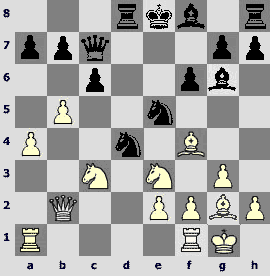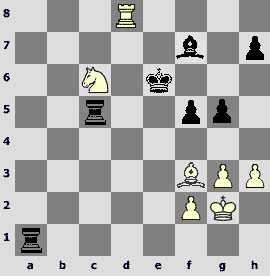17.01.2006
Wijk aan Zee round 4: Bacrot-Gelfand
Bacrot (2717) - Gelfand (2723)
Wijk aan Zee Netherlands (4), 17.01.2006
Annotated by Konstantin Sakaev
1.d4 d5 2.c4 c6 3.Nc3 Nf6 4.Nf3 dxc4 5.a4 Bf5 6.Ne5 Nbd7 7.Nxc4 Qc7 8.g3 e5 9.dxe5 Nxe5 10.Bf4 Nfd7
11.Bg2 f6

An old move from Capablanca-Vidmar, 1929. Morozevich also played it before inventing a modern 11...g5.
12.0-0 Nc5 This was the idea of Morozevich; 12...Be6, forcing to capture on e5 at once, was the regular way of handling the variation. 12...Be6 was tested in Alekhine-Euwe match.
13.Ne3 13.e4 Bg6 14.Bxe5 fxe5 15.f4 leads to a sharper game.
13...Bg6 14.b4 Ne6 15.b5 Rd8 16.Qb3, is probably the strongest, - 16...Nd4 17.Qb2. An alternative is 16.Qc1.
16.Qb3 Nd4 17.Qb2

This position has been tested on a high level just once: 17...Bc5 18.a5 0-0 19.a6 bxa6 20.bxc6 Ndxc6 21.Rxa6 Qc8 22.Ra4, ½-½ Riazantsev-Bareev, Kazan 2005. There is a feeling that White had a certain advantage.
17...Bc5 Now bad is 18.Ne4 Bxe4 19.Bxe4 g5 20.Bxe5 Qxe5, and White loses material. Interesting is 18.Rac1 or 18.Rfc1; one has to choose.
In general, in this position Black relies on a strong fist of his pieces on dark squares с5, d4, e5, supported by the f6-pawn. White, in turn, must play on light squares and on the c-file, using a loose position of the c5-bishop and undermining the c6-pawn by a4-a5-a6 (the way Riazantsev played).
18.Rfc1 A game between two amateurs continued 18...0-0 19.Ne4 Be7 20.Nd5 Govciyan,P-Hanley,C/Hyerois 2002.
18...Qe7 This is a novelty. The move looks fairly logical though: the bishop needed protection. Now White may proceed with 19.a5 0-0 20.a6 - then 20...b6 21.Bxe5 (21.bxc6 Nexc6 22.Ned5 Qf7 - the position is unclear) 21...fxe5 22.bxc6 e4 - Black has a compensation for a pawn.
19.bxc6 bxc6

Bacrot's decision came as a surprise. Now the queen on b2 is misplaced, and Black's pieces in the center are difficult to drive away. Maybe Black's position is already somewhat better. One can't find anything better than a move repetition for White: 20.Ne4 Bb4 21.Nc3, and in view of the Ncd5 threat the bishop has to return to c5.
20.Ne4
Leko stands better against Ivanchuk - he presses without risk. It is too early to draw any post-opening conclusions in Sokolov-Anand, but it looks pretty even. Mamedyarov has a minimal advantage against Tiviakov. Karjakin's compensation for a sacrificed pawn is sufficient to balance the game. Aronian had no problem equalizing against Kamsky. And, finally, Topalov has more than sufficient compensation after sacrificing an exchange against van Wely. After 13.Nd2 it would have been enough for equality, while the move that occurred in the game - 13.Ke2?! is clearly overoptimistic.
It looks like White may and should avoid the repetition: 20...Bb4 21.Nc4 Nxc4 22.Rxc4 c5 23.e3 Ne6 24.Nc3. The White's knight threatens to jump to d5, and there is a threat Bc6+, depriving Black of the right to castle. White's position is clearly better. More correct for Black is 21...0-0 22.Nxe5 Bxe4 23.Bxe4 fxe5, and he must be able to hold.
Kamsky has blundered a pawn and stands losing.
20...Bb4 21.Nc4
Position in van Wely-Topalov is completely unclear, and both players have their chances. Black compensation is not as huge as it was. Dubious 14...f5 allowed the White's knight to occupy the e5-outpost. After f2-f4 White can move the king to a safer although also not ideal location - to f2.
21...Nxc4 22.Rxc4 c5 23.e3
23...Bxe4 24.exd4 Bxg2 25.dxc5 is also in White's favor.
23...Ne6 24.Nc3 Nxf4 A bishop check from c6 looks sensible.
25.Bc6+ And 25...Kf8 will probably be followed by 26.Rxf4.
Karjakin agreed to a draw against Adams too early. The position is most likely drawn, but it is White (Adams) who must put an effort, while for Black continuing the game was risk-free. His last move - 24...Rxd2 - is an inaccuracy. One should have kept the rook on board by 24...Ra8.
It looks like Gelfand can play 25...Kf7! 26.Rf4 Qe6 27.Bb5 Bd3! Black is OK.
25...Kf8 26.Rxf4 Qe5 27.Rc1

A correct move. After the exchange sacrifice White would have fought for an equality. Now I like 27...a5, in order to strengthen the bishop. Black is completely in order.
27...a5 28.Bb5 Defending against Rd3.
28...Ke7. Gelfand stands better thanks to the d-file being controlled. Now he is going to double the rooks on it.
Answering Malthrope's question (scroll down to see his comment): in van Wely-Topalov it is the move 20 right now, and the evaluation hasn't changed: objectively the position is balanced, but Black's is much easier to handle. Van Wely consumes a lot of time, and the remaining 16 minutes might put him under great pressure. Topalov has a decent chance to win this game.
29.Qb3 Going away from the pin - there was no reasonable alternative to it.
29...Rd2 Рenetrate, since it is permitted! Black's next move is 29...Rhd8. And White should play e4 and Nd5.
30.e4 Rhd8 31.Nd5+ Kf8
Dear Gomez, I think Kamsky can safely resign. His position hasn't improved since he blundered a pawn...
32.Qf3 Black's position is better, but I think White can make a draw by playing solidly. The d5-knight is a mighty anchorman of the French team.
Now 32...Rd4 looks logical, threatening Bd2, while 32...Bxe4 is clearly wrong.
To Gomes (2): that's correct, I played against IM Karasev as White, and it was a draw, but I did not dare to move the king, preferring Nd2.
To richie: in my opinion, Leko's inclination to making draws roots in his character. He is rather coward...
32...Rd4 33.Rc4 Bd2

It suddenly appeared that White had no reasonable countermeasures against Black's concrete plan! Now Bacrot must seek salvation. Maybe it makes sense to give up the exchange on g4, taking Black's light-squared bishop. In this case Black will have to put a lot of effort into converting his material advantage: 34.Rg4!? (or 34.Rxd4 cxd4 - it is better to take with the pawn: 34...Qxd4 35.Rf5! - 35.Rg4, although I like it less) 34...Bh5 35.h3. White has some light-squared tricks after both 35...Bxg4 and 35...Rxc4 36.Bxc4 Bxg4. Those who had followed our relay of Svidler-Khalifman from the Russian superfinal probably remember how El Khalif failed to convert an extra exchange in a much more winning situation...
34.Rxc5? Bxf4 35.Nxf4. I don't like this for White at all! By the way, 34...Rxe4 was an immediate killer. But Gelfand's position is now winning - the Israeli only has to show some technique.
To Gustavo: more combative play in that game (Sokolov-Anand) was less likely. Anand is very solid as Black, and it indeed seems that Sokolov lacked ambition tonight.
35...Qxe4 Boris handled it imperfectly, thus he will be punished by converting his extra exchange with considerable technical difficulties in the endgame. We have good chances to hang on here till the very late!
Topalov finishes off van Wely. At some point there was a feeling that the Dutchnman got certain chances, but then the time pressure took its toll.
36.Bc6 Qxf3?! (more technical is 36...Qe1+ 37.Kg2 Bf7) 37.Bxf3 Bf7?

A natural move that suddenly turned a serious mistake. It was necessary to return the exchange: 37...Rxa4! wins after 38.Ne6+ Ke7 39.Nxd8 Ra1+ 40.Kg2 Kxd8.
38.Rxa5 g5 39.Ne2 Rc4 40.h3 Rd1+ 41.Kg2
Mamedyarov will likely lose his first game at Wijk aan Zee, although Tiviakov has certain technical difficulties. Aronian created problems for himself, although the overall evaluation hasn't changed. He rejectes logical-looking penetrating via the e-file, and keeps the rook on the d-file.
41...Ra1 42.Ra8+ Kg7 43.a5 Rca4 44.Rd8 Rxa5 45.Nd4
It seems Aronian has found the right idea, but they way he carries it out fails to impress. Still, I have my faith in Levon - he will eventually bring his rook to the e-file, penetrate the enemy camp and convert the advantage.
Tiviakov has difficulties converting an extra pieces. The chances to win and to draw are 50-50... No, it is already drawn - White has a perpetual. A clear draw, if he doesn't dare playing for a win by b5-b6... I will not be surprised!
Bacrot holds after 45...f5 46.Rd7 Kf6 47.Rd6+ Ke5 48.Rd7. See the note to the last moves before the time control to find out where Gelfand missed the win.
45...f5 46.Rd7 Kf6 47.Rd6+ Ke5 48.Rd8 I can't find a single reason why Bacrot rejected 48.Rd7. Still, no winning plan for Black can be observed. The computer is useless here, as its evaluation of the endgame R+2 vs. N+3 is completely wrong (the comp gives -+, while it is just drawn).
48...Rc5 49.Nc6+ Ke6

It seems I solved the riddle! Bacrot rejected 48.Rd7 because Black wins after 48...Bc4! 49.Nc6+ Ke6 50.Rxh7 Bf1+ 51.Kh2 R5a2+! And this means that the endgame is more unpleasant for White than I thought.
In Kamsky-Aronian Gata caught the luck! Aronian missed a nice resource 53.Bf4! 52...Bh2+ would have surely tempted me if I were in Levon's shoes. Now it looks drawn.
50.Rh8 Kf6 51.Rxh7 g4 52.hxg4 fxg4 53.Be4 Re1 54.Nd8 Bg8 55.Rh6+ Ke7,53.Be4 Re1 54.Nd8 Bg8 55.Rh6+ Ke7, and the knight has no time to retreat to a protected square.
53.Be4 Re1 54.Nd8 Bd5!
This wins simpler and nicer. 55.Bxd5 Rxd5 56.Rh6+ Kg7 57.Re6 Ra1! 58.Nc6 Rdd1, and Black gives a checkmate.
55.Rh6+ Ke7 The knight is lost, and the struggle is over. Bacrot loses the second game in a row!
56.Bxd5 Rxd5 57.Nc6+ Kd7 58.Rg6 Rdd1 59.Nb8+ Kc8 60.Rg8+ Kb7 61.Rxg4 Kxb8 White resigned. 0-1
Aronian nevertheless wins against Kamsky! Maybe Gata's defense in the concluding part of the game could be improved. But Gata still should receive his due for putting up a very stubborn and imaginative resistance after blundering a pawn.
The playing day, or, more precisely, the playing evening, was very long and laborous. It is a high time for a day off! We'll return on Thursday with the game Anand-Leko. Yes, Leko. I'm afraid we'll have no other chance to show an interesting game of the classical vice-champion if we miss his "Black" encounter with Anand. Don't worry, we'll turn to something else in case of a short draw. See you soon!
